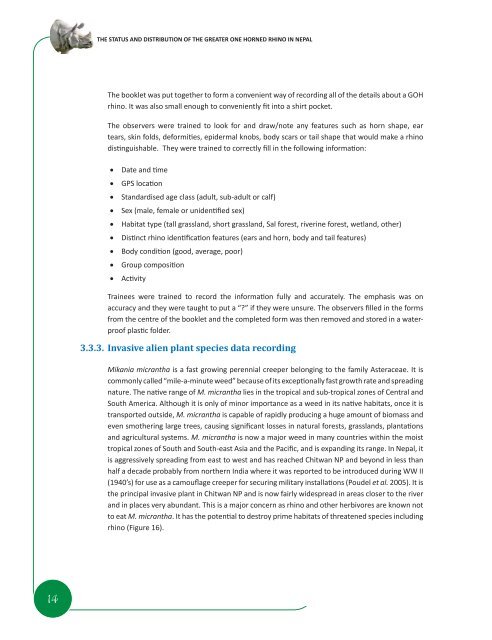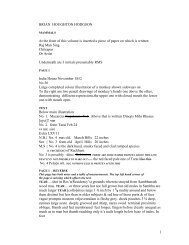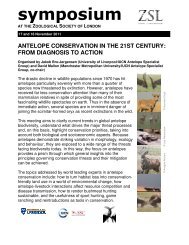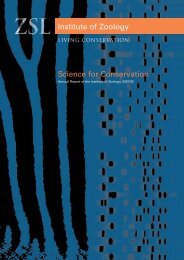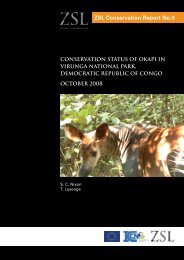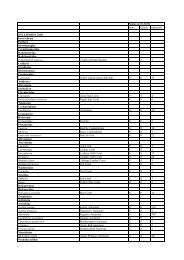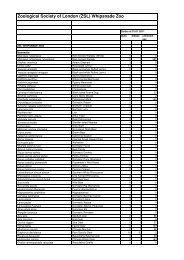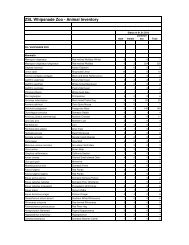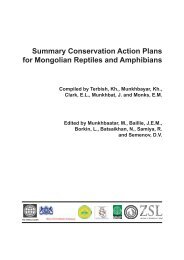the status and distribution of the greater one-horned rhino in nepal
the status and distribution of the greater one-horned rhino in nepal
the status and distribution of the greater one-horned rhino in nepal
Create successful ePaper yourself
Turn your PDF publications into a flip-book with our unique Google optimized e-Paper software.
14<br />
THE STATUS AND DISTRIBUTION OF THE GREATER ONE HORNED RHINO IN NEPAL<br />
The booklet was put toge<strong>the</strong>r to form a convenient way <strong>of</strong> record<strong>in</strong>g all <strong>of</strong> <strong>the</strong> details about a GOH<br />
<strong>rh<strong>in</strong>o</strong>. It was also small enough to conveniently fi t <strong>in</strong>to a shirt pocket.<br />
The observers were tra<strong>in</strong>ed to look for <strong>and</strong> draw/note any features such as horn shape, ear<br />
tears, sk<strong>in</strong> folds, deformiti es, epidermal knobs, body scars or tail shape that would make a <strong>rh<strong>in</strong>o</strong><br />
disti nguishable. They were tra<strong>in</strong>ed to correctly fi ll <strong>in</strong> <strong>the</strong> follow<strong>in</strong>g <strong>in</strong>formati on:<br />
• Date <strong>and</strong> ti me<br />
• GPS locati on<br />
• St<strong>and</strong>ardised age class (adult, sub-adult or calf)<br />
• Sex (male, female or unidenti fi ed sex)<br />
• Habitat type (tall grassl<strong>and</strong>, short grassl<strong>and</strong>, Sal forest, river<strong>in</strong>e forest, wetl<strong>and</strong>, o<strong>the</strong>r)<br />
• Disti nct <strong>rh<strong>in</strong>o</strong> identi fi cati on features (ears <strong>and</strong> horn, body <strong>and</strong> tail features)<br />
• Body conditi on (good, average, poor)<br />
• Group compositi on<br />
• Acti vity<br />
Tra<strong>in</strong>ees were tra<strong>in</strong>ed to record <strong>the</strong> <strong>in</strong>formati on fully <strong>and</strong> accurately. The emphasis was on<br />
accuracy <strong>and</strong> <strong>the</strong>y were taught to put a “?” if <strong>the</strong>y were unsure. The observers fi lled <strong>in</strong> <strong>the</strong> forms<br />
from <strong>the</strong> centre <strong>of</strong> <strong>the</strong> booklet <strong>and</strong> <strong>the</strong> completed form was <strong>the</strong>n removed <strong>and</strong> stored <strong>in</strong> a waterpro<strong>of</strong><br />
plasti c folder.<br />
3.3.3. Invasive alien plant species data record<strong>in</strong>g<br />
Mikania micrantha is a fast grow<strong>in</strong>g perennial creeper belong<strong>in</strong>g to <strong>the</strong> family Asteraceae. It is<br />
commonly called “mile-a-m<strong>in</strong>ute weed” because <strong>of</strong> its excepti onally fast growth rate <strong>and</strong> spread<strong>in</strong>g<br />
nature. The nati ve range <strong>of</strong> M. micrantha lies <strong>in</strong> <strong>the</strong> tropical <strong>and</strong> sub-tropical z<strong>one</strong>s <strong>of</strong> Central <strong>and</strong><br />
South America. Although it is only <strong>of</strong> m<strong>in</strong>or importance as a weed <strong>in</strong> its nati ve habitats, once it is<br />
transported outside, M. micrantha is capable <strong>of</strong> rapidly produc<strong>in</strong>g a huge amount <strong>of</strong> biomass <strong>and</strong><br />
even smo<strong>the</strong>r<strong>in</strong>g large trees, caus<strong>in</strong>g signifi cant losses <strong>in</strong> natural forests, grassl<strong>and</strong>s, plantati ons<br />
<strong>and</strong> agricultural systems. M. micrantha is now a major weed <strong>in</strong> many countries with<strong>in</strong> <strong>the</strong> moist<br />
tropical z<strong>one</strong>s <strong>of</strong> South <strong>and</strong> South-east Asia <strong>and</strong> <strong>the</strong> Pacifi c, <strong>and</strong> is exp<strong>and</strong><strong>in</strong>g its range. In Nepal, it<br />
is aggressively spread<strong>in</strong>g from east to west <strong>and</strong> has reached Chitwan NP <strong>and</strong> beyond <strong>in</strong> less than<br />
half a decade probably from nor<strong>the</strong>rn India where it was reported to be <strong>in</strong>troduced dur<strong>in</strong>g WW II<br />
(1940’s) for use as a camoufl age creeper for secur<strong>in</strong>g military <strong>in</strong>stallati ons (Poudel et al. 2005). It is<br />
<strong>the</strong> pr<strong>in</strong>cipal <strong>in</strong>vasive plant <strong>in</strong> Chitwan NP <strong>and</strong> is now fairly widespread <strong>in</strong> areas closer to <strong>the</strong> river<br />
<strong>and</strong> <strong>in</strong> places very abundant. This is a major concern as <strong>rh<strong>in</strong>o</strong> <strong>and</strong> o<strong>the</strong>r herbivores are known not<br />
to eat M. micrantha. It has <strong>the</strong> potenti al to destroy prime habitats <strong>of</strong> threatened species <strong>in</strong>clud<strong>in</strong>g<br />
<strong>rh<strong>in</strong>o</strong> (Figure 16).


